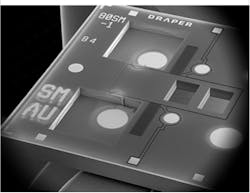Sensors provide critical information in both military and commercial environments. For warfighters, they warn of enemy movements. For civilians, they will soon be part of Internet of Things (IoT) devices everywhere and helping to guide autonomous, “self-driving” cars. But those sensors rely on being active at all times and using a great deal of battery power in the process. This might change with a sensor developed by Draper that requires far less power to operate (see figure). It essentially wakes up when needed and draws almost zero standby power, using microelectromechanical-systems (MEMS) technology.
“Sensors constantly consume power, with much of that power spent processing what often turns out to be irrelevant data or noise,” said Jonathan Bernstein, a microelectromechanical engineer at Draper. “We solved that by designing a zero-power acoustic wake-up switch actuated by environmental sounds that will enable sensor systems to last for years, limited only by battery discharge rates.” This discovery could help extend the using operating lifetimes of both military sensors and the sensors expected to be produced by the billions (or even trillions) for IoT applications.
MEMS technology is the basis for an acoustic switch that will energize a sensor when needed to save long-term power and battery life.
“One area where sensor systems need to advance is power consumption and battery life,” said Marc Weinberg, design engineer in Draper’s Mechanical Engineering and System Packaging division. “As sensors move into more applications—from the military to our homes to the Internet of Things—there’s a search on for ways to optimize battery consumption. We believe an acoustic wake-up switch shows promise for the future of sensors.”
The current research into MEMS, which is funded by DARPA for its N-Zero Program, is part of Draper’s materials engineering and microfabrication portfolio. Draper develops sensors for energy, transportation, defense, and cybersecurity markets, and makes extremely small, cost-effective sensors with high sensitivity and resolution.
About the Author
Jack Browne
Technical Contributor
Jack Browne, Technical Contributor, has worked in technical publishing for over 30 years. He managed the content and production of three technical journals while at the American Institute of Physics, including Medical Physics and the Journal of Vacuum Science & Technology. He has been a Publisher and Editor for Penton Media, started the firm’s Wireless Symposium & Exhibition trade show in 1993, and currently serves as Technical Contributor for that company's Microwaves & RF magazine. Browne, who holds a BS in Mathematics from City College of New York and BA degrees in English and Philosophy from Fordham University, is a member of the IEEE.


